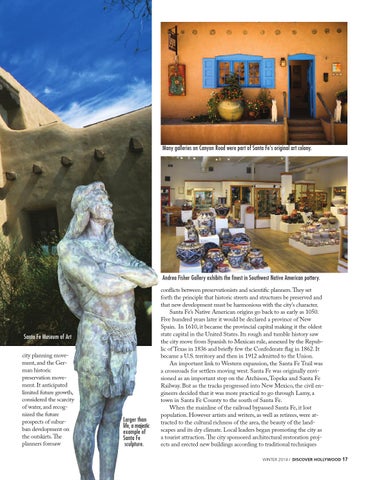Many galleries on Canyon Road were part of Santa Fe’s original art colony.
Andrea Fisher Gallery exhibits the finest in Southwest Native American pottery.
Santa Fe Museum of Art city planning movement, and the German historic preservation movement. It anticipated limited future growth, considered the scarcity of water, and recognized the future prospects of suburban development on the outskirts. e planners foresaw
Larger than life, a majestic example of Santa Fe sculpture.
conflicts between preservationists and scientific planners. ey set forth the principle that historic streets and structures be preserved and that new development must be harmonious with the city's character. Santa Fe’s Native American origins go back to as early as 1050. Five hundred years later it would be declared a province of New Spain. In 1610, it became the provincial capital making it the oldest state capital in the United States. Its rough and tumble history saw the city move from Spanish to Mexican rule, annexed by the Republic of Texas in 1836 and briefly few the Confederate flag in 1862. It became a U.S. territory and then in 1912 admitted to the Union. An important link to Western expansion, the Santa Fe Trail was a crossroads for settlers moving west. Santa Fe was originally envisioned as an important stop on the Atchison, Topeka and Santa Fe Railway. But as the tracks progressed into New Mexico, the civil engineers decided that it was more practical to go through Lamy, a town in Santa Fe County to the south of Santa Fe. When the mainline of the railroad bypassed Santa Fe, it lost population. However artists and writers, as well as retirees, were attracted to the cultural richness of the area, the beauty of the landscapes and its dry climate. Local leaders began promoting the city as a tourist attraction. e city sponsored architectural restoration projects and erected new buildings according to traditional techniques WINTER 2014 / DISCOVER HOLLYWOOD 17
